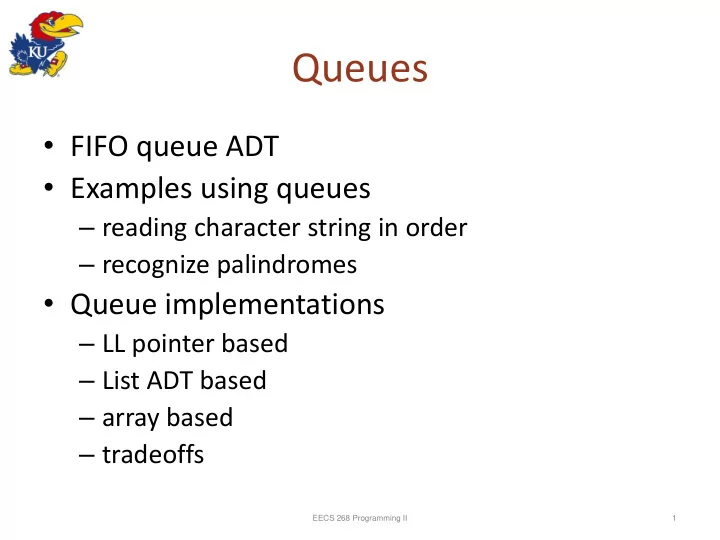

Queues • FIFO queue ADT • Examples using queues – reading character string in order – recognize palindromes • Queue implementations – LL pointer based – List ADT based – array based – tradeoffs EECS 268 Programming II 1
The Abstract Data Type Queue • Another common linear data structure similar to the stack • Queue is an ADT with following properties – elements are kept in their order of arrival – new items enter at the back, or rear, of the queue – items leave from the front of the queue • Thus queue has first-in, first-out (FIFO) property – nicely models several real-world processes • line to buy movie tickets, or queue jobs and print requests EECS 268 Programming II 2
The Abstract Data Type Queue • ADT queue operations – Create an empty queue – Destroy a queue – Determine whether a queue is empty – Add a new item to the queue – Remove the item that was added earliest – Retrieve the item that was added earliest EECS 268 Programming II 3
The Abstract Data Type Queue • Operation Contract for the ADT Queue – isEmpty():boolean {query} – enqueue(in newItem:QueueItemType) throw QueueException – dequeue() throw QueueException – dequeue(out queueFront:QueueItemType) throw QueueException – getFront(out queueFront:QueueItemType) {query} throw QueueException EECS 268 Programming II 4
The Abstract Data Type Queue Figure 7-2 Some queue operations EECS 268 Programming II 5
Example 1: Ordering Character String • A queue can retain characters in the order in which they are typed aQueue.createQueue() while (not end of line) { Read a new character ch aQueue.enqueue(ch) } // end while • Once the characters are in a queue, the system can process them as necessary EECS 268 Programming II 6
Example2: Recognizing Palindromes • A palindrome is a string of characters that reads the same backwards and forwards – RADAR, MADAM, EYE, etc. • Observations – stack reverses the order of occurrences – queue preserves the order of occurrences • A palindrome stored in both stack and queue will display a match when retrieved EECS 268 Programming II 7
Example2: Recognizing Palindromes • A nonrecursive recognition algorithm for palindromes – traverse character string from left to right – insert each character into both a queue and a stack – compare the characters at the front of the queue and the top of the stack see C7-palin.cpp EECS 268 Programming II 8
Implementations of the ADT Queue • Linked list based queue implementation – can maintain pointers to front and back of Queue – circular linked list with one external reference also possible • Using ADT List class to implement queue – possible less efficient, but simple • An array-based queue implementation – problem of rightward-drift EECS 268 Programming II 9
Linked List Implementations Figure 7-4 A pointer-based implementation of a queue: (a) a linear linked list with two external pointers; (b) a circular linear linked list with one external pointer EECS 268 Programming II 10
Operations in LL Implementation Figure 7-5 Inserting an item into a nonempty queue Figure 7-6 Inserting an item into an empty queue: (a) before insertion; (b) after insertion Figure 7-7 Deleting an item from a queue of more than one item see C7-QueueP.cpp 11
List Based Queue Implementation • Queue operations map well to ADT List operations – enqueue(item) insert(getLength()+1, item) – dequeue() remove(1) – getFront(qfront) retrieve(1, qfront) • We can built the queue ADT as a wrapper over the List ADT see C7-QueueL.cpp EECS 268 Programming II 12
An Array-Based Implementation • Using arrays is slightly more complex – naïve implementation causes rightward drift – queue appears full even when array does not hold MAX_QUEUE-1 elements • Solutions to rightward drift – always copy array elements to left – expensive – maintain circular array – how to detect queue full/empty? EECS 268 Programming II 13
Circular Array Implementation • Problem: – front == (back+1) is true for both queue full & empty • Solution: – use integer counter to hold size of queue – update on each enqueue/dequeue EECS 268 Programming II 14
An Array-Based Implementation • Initialize the queue, front = 0, back = MAX_QUEUE – 1, count = 0 • Inserting into a queue back = (back+1) % MAX_QUEUE; items[back] = newItem; ++count; • Deleting from a queue front = (front+1) % MAX_QUEUE; --count; see C7-QueueA.cpp EECS 268 Programming II 15
Array Implementation Variations • Use a flag isFull to distinguish between the full and empty conditions • Declare MAX_QUEUE + 1 locations for the array items, but use only MAX_QUEUE of them for queue items EECS 268 Programming II 16
Comparing Implementations • Static arrays Vs. dynamically allocated LLs – enqueue operation cannot add item if array is full – no size restriction with LL (unless memory full) • LL Vs List bases array implementations – LL-based implementation is more efficient – ADT list approach reuses already implemented class • much simpler to write • saves programming time EECS 268 Programming II 17
A Summary of Position-Oriented ADTs • Position-oriented ADTs – List – Stack – Queue • Stacks and queues – Only the end positions can be accessed • Lists – All positions can be accessed EECS 268 Programming II 18
A Summary of Position-Oriented ADTs • Stacks and queues are very similar – Operations of stacks and queues can be paired off • createStack and createQueue • Stack isEmpty and queue isEmpty • push and enqueue • pop and dequeue • Stack getTop and queue getFront EECS 268 Programming II 19
Summary • ADT queue has first-in, first-out (FIFO) behavior • Circular array eliminates the problem of rightward drift in array-based implementation • To distinguish between the queue-full and queue- empty conditions in a circular array – count the number of items in the queue – use an isFull flag – leave one array location empty • LL and List ADT based implementations possible EECS 268 Programming II 20
Recommend
More recommend